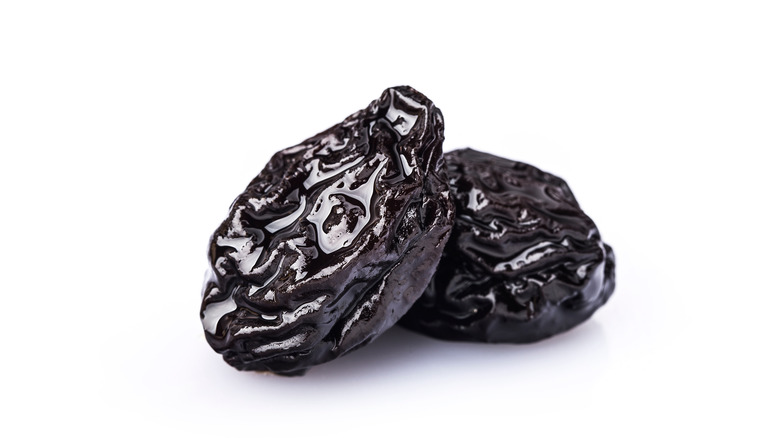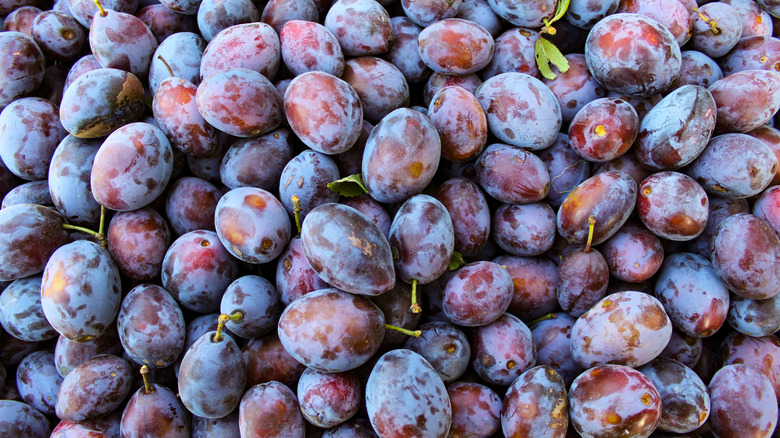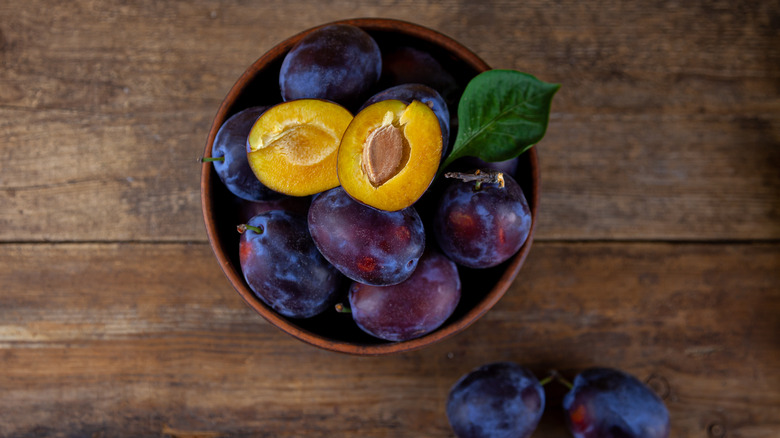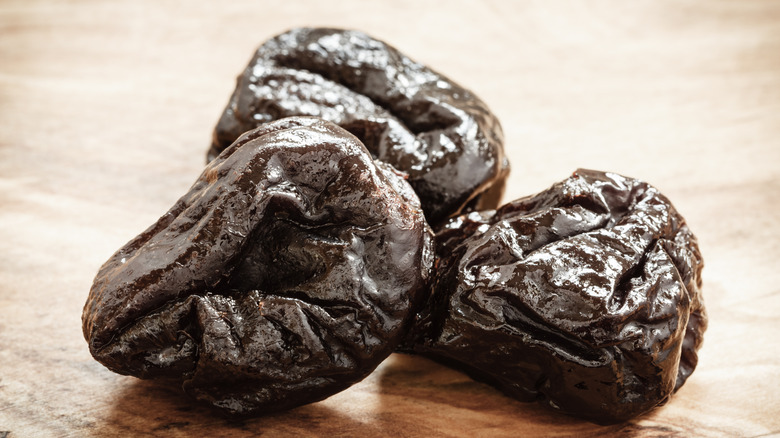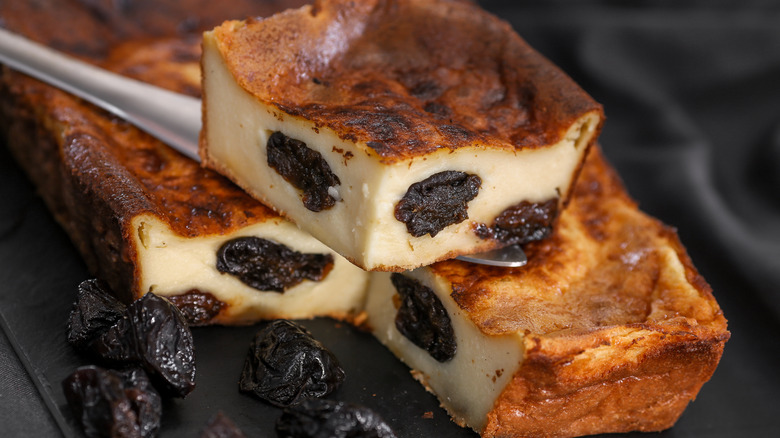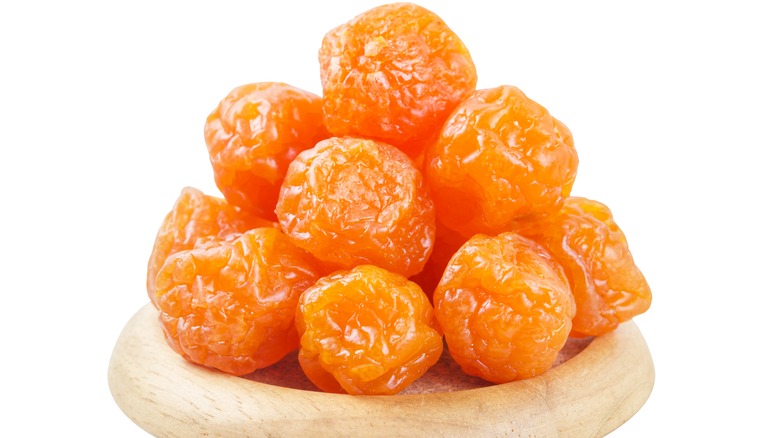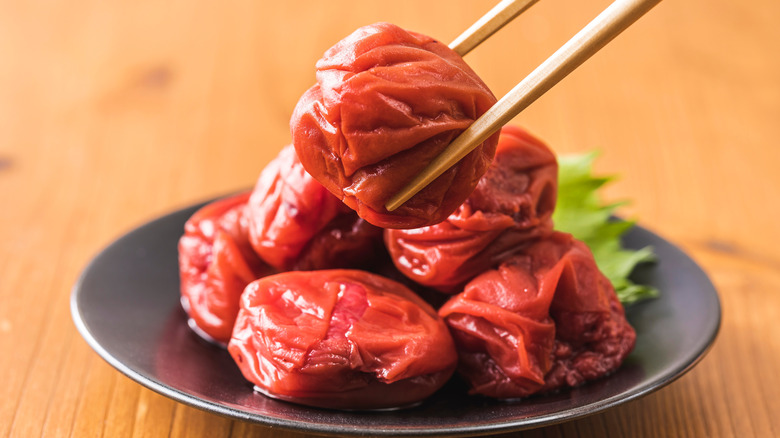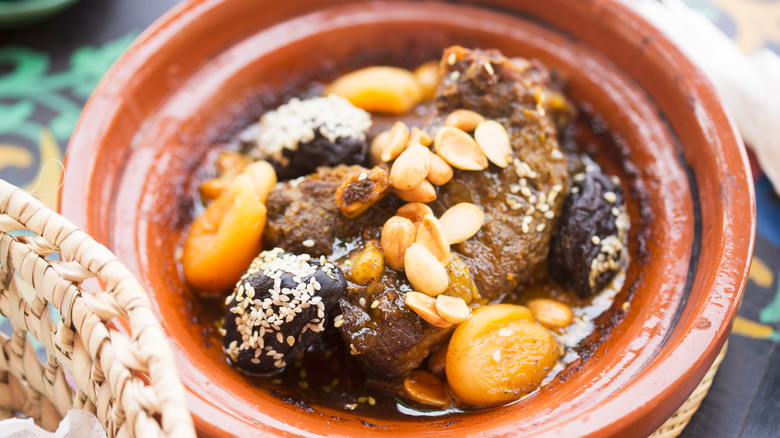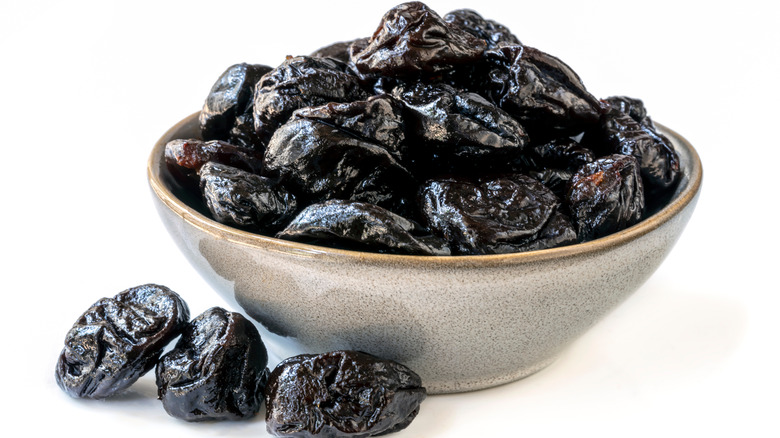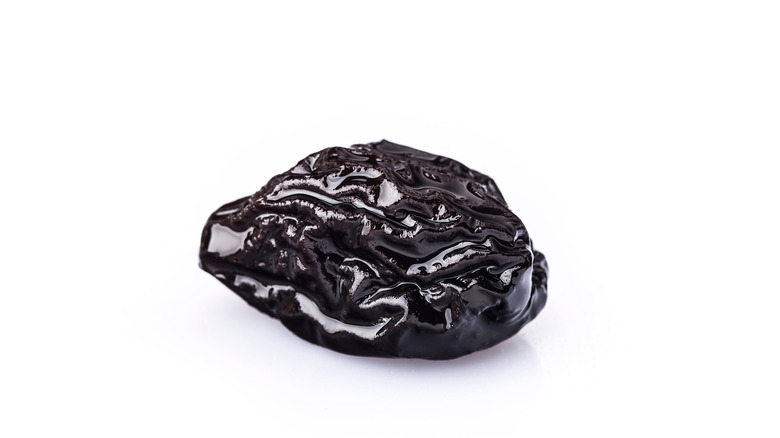The Untold Truth Of Prunes
Prunes, it must be said, are far from being the sexiest of fruits. Long associated with constipation and digestive discomfort, Healthline notes, they're a food you'd once be far more likely to find in grandma's cupboard than in your own supermarket cart.
But the times, as Bob Dylan is wont to say, are a-changing — for the humble prune, that is. From a marketing makeover in California to growing popularity as an on-trend item in Japan to the resurfacing of classic recipes from France, Japan, Morocco, and beyond, prunes are finally getting the acclaim they've long deserved.
Want to know what makes prunes in California so different from those in China? Interested to find out whether they're really that good for your gut as you've long been told? On the lookout for delicious recipes from around the world, both savory and sweet, in which to enjoy them? Then friend, you've come to the right place.
Prunes and dried plums are the same thing
The taxonomy of dried fruits can certainly seem ... odd. Why, for example, do we call dried apricots dried apricots, but dried grapes raisins? The answer, it turns out, comes from the English language's penchant for double-borrowing words from French — see guarantee and warranty for a prime example. According to the Online Etymology Dictionary, raisin comes from the Anglo-French raycin, while grape comes from the Old French grape, the latter of which actually referred, not to a single grape, but rather to a bunch of them, as in the modern French grappe. The former, meanwhile, could once refer to both the fresh and dried fruit, as raisin still does in French today.
The word prune in English refers to the dried fruit of the plum, and a similar odd borrowing pattern is at the core of the discrepancy between the two ... with even more oddities. After all, in modern French, the word prune refers to the fresh plum; the word pruneau is used for the dried fruit. Plum, meanwhile, has Germanic roots and comes from the Old English word plume.
... Got that straight?
Not all plums can become prunes
While a prune is just a dried plum, not all plums can be dried into prunes. According to The Spruce Eats, prunes must be made from certain plum varieties intended to be dried, most of which are freestone varieties, which means that the pit is easier to remove. Most prunes in America, the outlet notes, are made with the Petite d'Agen plum, a French variety that was first brought to California from France back in 1856 and grafted onto the American plum tree.
This variety got its start when 12th-century monks of the French Abbey of Clairac decided to graft local plum trees with Syrian ones that had arrived in Europe thanks to Crusaders. The resulting variety, the outlet asserts, was dubbed Prune d'Ente, a word linked to the Old French for "to graft."
Once this variety had been perfected, the city of Agen soon became a center for prune shipments, with the plums dried either in the sunshine or in bakers' ovens. These days, the crème de la crème of French prunes still bear the name of this city, and, according to The Spruce Eats, almost 99% of American prunes are made from this variety.
Most prunes come from California
While prunes arrived in California late compared to places like France, China, and the Middle East, which have enjoyed them for centuries, today, California produces 99% of the prunes sold in the U.S., as well as 70% of prunes sold around the world. The California Prune Board is more modest, claiming it only produces 40% of the world's prunes. Japan, according to a press release from the California Prune Board, is the biggest international market for the dried fruit.
California's mild climate, rich soil, and long growing season are particularly well-suited for growing prunes. It's no surprise, then, that according to California Prunes, the fruit from this region soon acquired an excellent reputation — and even paved the way for prune counterfeiting, with producers falsely claiming their prunes hailed from the Golden State! It was in 1908 that the Dried Fruit Association of California was formed to protect the reputation of California-grown prunes and even improve them, developing technologies to help keep prunes moister for longer periods of time.
While once grown predominantly in the Santa Clara Valley, California Prunes asserts that by 1960, California prune production had relocated to the Sacramento Valley. Today, according to the University of California's Division of Agriculture and Natural Resources, 80% of Californian prune production hails from the Sacramento Valley, while the remaining 20% comes from the San Joaquin Valley.
Prunes are the secret behind a classic Breton dessert
With their naturally sweet flavor, it's perhaps no wonder that prunes have long been embraced as a sweetener for desserts. In France, this gave way to a specialty known as Far Breton. This dessert came to be in Brittany in the 19th century, according to Comme des Français, when local Breton fishermen traded cod for Agen prunes. Rich in vitamin C, prunes were the ideal snack for sailors to help prevent scurvy, according to the outlet (the same reason, by the way, that English soldiers enjoyed limes and thus earned their nickname of limeys, according to the University of Massachusetts).
According to French Today, Far Breton is the most popular dessert in Brittany, thanks in part to the ease with which it is prepared at home. Similar to a clafoutis or flan (though according to the outlet, Bretons balk at the comparison), Far Breton is made with a vanilla-scented custard studded generously with sweet, fudgy prunes.
The first wild plums (and prunes) were sour and hail from China
While most American prunes come from a French variety, the original prune hails not from Europe, but rather from China, according to Lou Prunel. The French prune producer explains that the plum tree originally came to the Mediterranean basin from China by way of the Silk Road. And back in China, from these plums, a distinctly different sort of prune developed.
According to Bon Appétit, Chinese prunes blend sweet, sour, and salty flavors, uniting the dried plum with salt, sugar, and occasionally other flavors like licorice, clove, or citrus.
The outlet adds that two forms of these prunes are available on the market today: a saltier and tarter version called huamei, and the sweeter iteration dubbed chan pui mui. Seen as much a snack as a natural remedy for nausea, these plums can be enjoyed as-is, or added to dishes both savory and sweet.
Japanese prunes are considered quite fashionable
If Japan is the biggest international market for the dried fruit, it's no surprise: Prunes are on trend in Japan, according to Bakery and Snacks, which indicates that they are touted there as much for their flavor as for their health benefits. Speaking to the outlet back in 2013, Tom Leahy, president of Sunsweet's global sales agent CropSource International, saw this as a major benefit for bakeries seeking to launch new baked goods featuring the dried fruit, which have been wholeheartedly embraced by the "fairly high percentage of young Asian women suffer[ing] from digestive problems," he asserted.
"Prunes in Japan are considered a young woman's food," he told the outlet. "They are really fashionable in Japan."
But prunes are nothing new, in Japan. After all, the country has its own pickled prune, umeboshi, which according to Chopstick Chronicles, is made from dried and preserved plums and boasts a sour, salty flavor. Frequently used as a filling for onigiri or a garnish for bento boxes, umeboshi, like Chinese prunes, is as much a seasoning as it is a natural home remedy for digestion and fatigue.
Prunes are very popular in the Middle East
Prunes are incredibly popular in Middle Eastern countries, and are used in dishes both savory and sweet.
According to Arab News, prunes are particularly popular during the fasting month of Ramadan, during which, according to Chef Simon, prunes join other dried fruit as specialties to be enjoyed either on their own or cooked into dishes like tagines.
Lamb tagine, for example, is a popular dish in both Morocco and Algeria, according to Ricardo Cuisine, made with a combination of meat, spices, nuts, and dried fruit. The spices used in a tagine often include the category known in the West as "baking spices," such as cinnamon, ginger, and clove, which lend even more sweetness to the finished dish. According to Taste Atlas, Algerian lham lahlou (or sweet meat) is a dish of lamb in a sweet, spiced syrup simmered with fruit that is frequently served to break the Ramadan fast.
Prunes are very healthy
Prunes are a total superfood that boast loads of health benefits. Many of these stem from their impressive fiber content, which, the BBC notes, contribute notably to their cholesterol-lowering benefits, proven by research from the University of California, Davis. Fiber is also partially responsible for their ability to support healthy digestion, though Good Housekeeping notes these benefits can also be attributed to their phenolic compounds.
Prunes' antioxidant load, meanwhile, helps to lower general inflammation, according to Good Housekeeping, and may even slow aging, according to the BBC. Their richness in certain phytochemicals may also reduce the risk of diabetes, according to the BBC.
Good Housekeeping further notes that prunes are particularly beneficial for bone health, citing a study that found that consuming five to six prunes a day could keep postmenopausal women from suffering bone loss. According to NDTV Food, prunes can also improve eye health, due to their vitamin A content. Thanks to their richness in potassium, they may improve heart health, too.
Yes, prunes make you poop
If you know only one thing about prunes, we'd bet anything it's that they're a phenomenal aid for constipation. And this is no myth! According to the BBC, the combination of fiber, sorbitol, phytonutrients, and prebiotic properties contained in prunes work to support healthy digestion and bowel movements. In layman's terms, prunes help you poop more and more frequently; they're essentially nature's laxative (though the Guardian reports that the European Food Safety Agency ruled that they cannot be sold as such).
Whatever the Agency says, the facts are these: Studies have shown that prunes — especially when combined with water — can improve bowel function in as little as a month, and prune juice, despite its lack of fiber as compared to whole prunes, has been found to help with constipation, according to Healthline.
That said, a word of warning: Eating too many prunes, according to Livestrong, can lead to some unpleasant side effects including bloating, gas, diarrhea, and dehydration. (And eating too much of any dried fruit has been linked to other issues, including weight gain.)
Californian prune makers attempted a rebrand in 2000 to appeal to younger consumers
Prunes' association with constipation led the California Prune Board to attempt a rebrand back in 2000, according to The Packer. For nearly 20 years, the outlet reports, the Board changed its name to the California Dried Plum Board. And that's not all! The Spruce Eats notes that the prune industry also attempted other names, like "plum raisins."
Why the identity crisis? According to experts, it was mainly to distance itself from associations with older populations and digestive discomfort. Delighted Cooking claims that the rebrand was made principally to appeal to a younger market of shoppers, and NDTV Food notes that the decision was made following research that found that women between the ages of 25 and 54 reacted negatively to the idea of prunes.
In 2019, however, the Board changed tacks and reverted back to its old name, The Packer notes. The California Prune Board website claims that the choice was made to show that the board was "returning to [its] roots and embracing [its] essence and proclaiming the wonders of California Prunes with pride."
